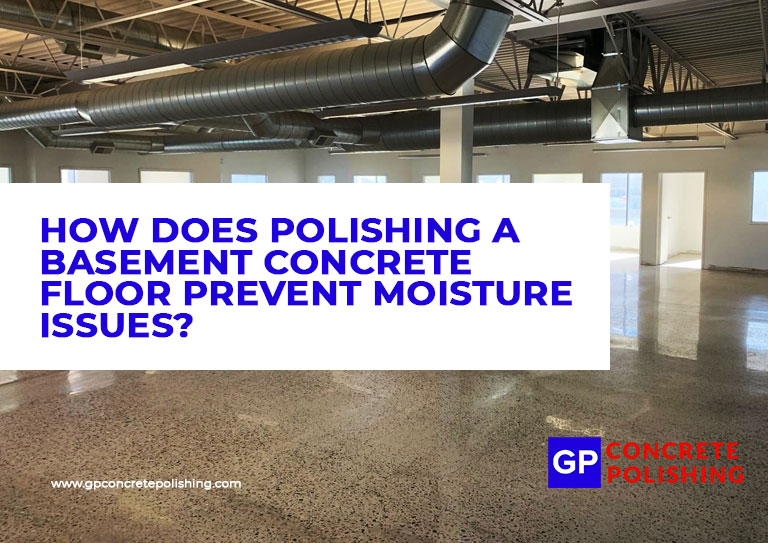
Basements are particularly vulnerable to moisture problems due to their location below ground level, where water infiltration, condensation, and humidity are common. Left unaddressed, moisture can lead to mold growth, structural damage, and unhealthy indoor air quality.
One effective strategy for managing basement moisture is basement floor polishing. While commonly associated with aesthetics and durability, polished concrete also provides a surprising level of moisture resistance.
By understanding how concrete floor polishing works, homeowners can make informed decisions to protect their basements from persistent dampness and its costly consequences.
Seals the Surface to Reduce Porosity
Concrete is naturally porous, which means it can absorb water over time. Polishing helps reduce this porosity, creating a denser surface that resists moisture intrusion.
- Densifies the concrete structure: The polishing process includes applying a chemical densifier. This substance reacts with the concrete to fill pores and harden the surface, reducing its ability to absorb water.
- Minimizes water seepage from below: A polished floor is far less likely to absorb groundwater vapor: This reduces the risk of musty odors or damp spots in the basement.
- Creates a moisture-resistant barrier: While not fully waterproof, the polished finish significantly lowers permeability. This makes it a strong preventative measure against rising damp or vapor transmission.
Eliminates the Need for Moisture-Trapping Materials
Traditional basement flooring options, like carpet or vinyl, can trap moisture and lead to mold and mildew. Polished concrete eliminates that risk by staying breathable yet sealed.
- Avoid adhesives and underlayments: Many floor coverings require glues or pads that trap moisture. Polished concrete is a single, solid, moisture-resistant flooring surface that allows moisture to evaporate naturally.
- No organic materials to feed mold: Unlike wood or carpet, concrete doesn’t provide food for mold: When polished, it becomes even more resistant to microbial growth.
- Low risk of bubbling or peeling: Surface coatings or tiles often lift due to vapor pressure. Polished concrete bonds to the substrate, reducing the chance of delamination or blistering.
Improves Basement Air Quality
A polished concrete floor not only controls moisture but also supports a healthier indoor environment by reducing allergens and microbial activity.
- Reduces relative humidity in the space: By resisting water infiltration, polished concrete helps stabilize moisture levels: This lowers the chance of excess humidity, which can lead to respiratory issues.
- Discourages mold and mildew formation: Mold needs moisture and organic matter to thrive; A polished, non-porous surface denies both, making it an inhospitable environment.
- Easy to clean and disinfect: Polished concrete requires minimal upkeep and doesn’t harbor dust or bacteria. This improves air quality and makes it easier to maintain a healthy space.
Minimizes Condensation and Surface Dampness
Condensation often forms on cool, porous basement floors. Polished concrete reduces this effect by altering the surface’s thermal and moisture behavior.
- Regulates surface temperature more efficiently: Polished concrete retains less surface moisture than unfinished concrete. This reduces the temperature difference between the floor and the surrounding air, limiting condensation.
- Repels water on contact: Polished concrete often exhibits hydrophobic qualities: Liquids stay on the surface instead of soaking in, allowing easy cleanup and preventing absorption.
- Reduces cold, damp feeling underfoot: The polishing process smooths and refines the floor’s texture: This creates a more comfortable and dry-feeling surface, even in humid conditions.
Supports Long-Term Moisture Management
Polishing is not a temporary solution; when done correctly, it provides years of moisture resistance and reduces maintenance needs.
- Durable and permanent finish: Polished concrete doesn’t peel, chip, or degrade like coatings. Once completed, it lasts for decades with proper care.
- Compatible with other basement waterproofing systems: Polished concrete can be part of a comprehensive moisture control plan. It pairs well with interior drainage systems or vapor barriers for added protection.
- Reduces future repair costs: Moisture damage can be costly and time-consuming to fix. Polishing helps prevent those issues from occurring in the first place, making it a smart investment.
Moisture issues in the basement can be a constant source of frustration for homeowners, leading to structural concerns and health hazards. Polishing the concrete floor is a proactive and effective way to combat this challenge.
By sealing the surface, avoiding moisture-trapping materials, and improving air quality, polished concrete floors provide both functional and aesthetic benefits. For those looking to create a dry, low-maintenance, and long-lasting basement environment, concrete polishing offers a practical and professional solution.

Comments are closed